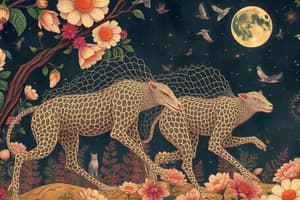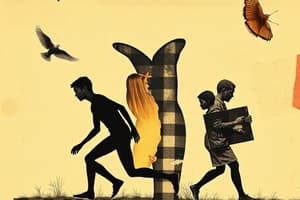Podcast
Questions and Answers
What do evolutionary trees visually represent?
What do evolutionary trees visually represent?
- The evolutionary relationships among species (correct)
- The physical similarities among living organisms
- The geographical distribution of species
- The fossil records of ancient life forms
Which aspect of evolutionary trees often indicates the time elapsed since divergence?
Which aspect of evolutionary trees often indicates the time elapsed since divergence?
- The branch lengths (correct)
- The labels of the nodes
- The number of leaves on the tree
- The color of the branches
What type of data do modern evolutionary trees utilize for accuracy?
What type of data do modern evolutionary trees utilize for accuracy?
- Morphological characteristics and behavior
- Fossil evidence and geological data
- Taxonomic classifications and family trees
- Genetic similarities and molecular data (correct)
In comparative embryology, what does the study reveal about different species?
In comparative embryology, what does the study reveal about different species?
What do nodes on an evolutionary tree represent?
What do nodes on an evolutionary tree represent?
What is a primary outcome of natural selection over many generations?
What is a primary outcome of natural selection over many generations?
Which type of speciation occurs due to geographic isolation?
Which type of speciation occurs due to geographic isolation?
What role do mutations play in evolution?
What role do mutations play in evolution?
How does genetic drift differ from natural selection?
How does genetic drift differ from natural selection?
What is a key factor that prevents interbreeding between newly formed species during speciation?
What is a key factor that prevents interbreeding between newly formed species during speciation?
What type of structures suggest common ancestry between species?
What type of structures suggest common ancestry between species?
Which process would most likely lead to the fixation of a rare allele in a small population?
Which process would most likely lead to the fixation of a rare allele in a small population?
What do fossil records primarily provide evidence for in the context of evolution?
What do fossil records primarily provide evidence for in the context of evolution?
What is the primary way natural selection influences the genetic makeup of a population?
What is the primary way natural selection influences the genetic makeup of a population?
Which type of mutation is most likely to enhance an organism's fitness in its environment?
Which type of mutation is most likely to enhance an organism's fitness in its environment?
How does genetic drift predominantly affect small populations compared to large populations?
How does genetic drift predominantly affect small populations compared to large populations?
What represents an example of allopatric speciation?
What represents an example of allopatric speciation?
Which of the following is NOT a mechanism of reproductive isolation?
Which of the following is NOT a mechanism of reproductive isolation?
What does the fossil record primarily illustrate about the history of life on Earth?
What does the fossil record primarily illustrate about the history of life on Earth?
What process can lead to a significant loss of genetic diversity in a population?
What process can lead to a significant loss of genetic diversity in a population?
Which characteristic distinguishes beneficial mutations from harmful mutations?
Which characteristic distinguishes beneficial mutations from harmful mutations?
Flashcards
Natural Selection
Natural Selection
Organisms better suited to their environment survive and reproduce more, changing the population's genetic makeup over time.
Speciation
Speciation
The process of new species forming from existing ones, often through reproductive isolation.
Mutation
Mutation
Random changes in DNA that introduce new genetic variations.
Genetic Drift
Genetic Drift
Signup and view all the flashcards
Fossil Record
Fossil Record
Signup and view all the flashcards
Homologous Structures
Homologous Structures
Signup and view all the flashcards
Allopatric Speciation
Allopatric Speciation
Signup and view all the flashcards
Sympatric Speciation
Sympatric Speciation
Signup and view all the flashcards
Reproductive Isolation
Reproductive Isolation
Signup and view all the flashcards
Comparative Embryology
Comparative Embryology
Signup and view all the flashcards
Molecular Biology
Molecular Biology
Signup and view all the flashcards
Evolutionary Tree
Evolutionary Tree
Signup and view all the flashcards
Phylogenetic Tree
Phylogenetic Tree
Signup and view all the flashcards
Nodes (on tree)
Nodes (on tree)
Signup and view all the flashcards
Branch Lengths
Branch Lengths
Signup and view all the flashcards
Shared Characteristics
Shared Characteristics
Signup and view all the flashcards
Modern Evolutionary Trees
Modern Evolutionary Trees
Signup and view all the flashcards
Natural Selection
Natural Selection
Signup and view all the flashcards
Mutations
Mutations
Signup and view all the flashcards
Genetic Drift
Genetic Drift
Signup and view all the flashcards
Speciation
Speciation
Signup and view all the flashcards
Allopatric Speciation
Allopatric Speciation
Signup and view all the flashcards
Sympatric Speciation
Sympatric Speciation
Signup and view all the flashcards
Reproductive Isolation
Reproductive Isolation
Signup and view all the flashcards
Fossil Record
Fossil Record
Signup and view all the flashcards
Variation
Variation
Signup and view all the flashcards
Adaptation
Adaptation
Signup and view all the flashcards
Study Notes
Natural Selection
- Natural selection is the process where organisms better adapted to their environment tend to survive and produce more offspring.
- This leads to changes in the genetic makeup of a population over time.
- Key components of natural selection include variation within a population, inheritance of traits, differential survival and reproduction, and adaptation over time.
- Environmental pressures drive natural selection, selecting for traits that enhance survival and reproduction.
- Organisms with advantageous traits are more likely to pass those traits to their offspring.
- Over many generations, these advantageous traits become more common within the population, resulting in adaptation to the environment.
Speciation
- Speciation is the evolutionary process by which new biological species arise.
- It involves the splitting of one ancestral species into two or more descendant species.
- Speciation can occur through various mechanisms, including allopatric speciation (geographic isolation), sympatric speciation (speciation within the same geographic area) and parapatric speciation which occurs between populations with some gene flow but separated by an environmental gradient.
- Reproductive isolation is a crucial component of speciation, preventing gene flow between newly formed species. This can result from behavioural, geographical, temporal, or genetic differences.
- Reproductive isolation mechanisms ensure that species remain distinct and prevent interbreeding.
Mutation and Genetic Drift
- Mutations are random changes in the DNA sequence.
- These changes can be beneficial, harmful, or neutral.
- Mutations introduce new genetic variation into a population, providing raw material for natural selection to act upon.
- Genetic drift is a random change in the frequency of alleles in a population, particularly pronounced in small populations.
- It can cause the loss of rare alleles from a population, or the fixation of other alleles.
- Genetic drift has a bigger influence on smaller populations than larger ones. Random events can significantly alter allele frequencies in a small population over time.
Evidence of Evolution
- Fossil records provide a chronological sequence of life forms, illustrating lineages and extinctions.
- Similar anatomical structures (homologous structures), both in their presence and their variations, suggest common ancestry between species.
- Comparative embryology reveals similarities in embryonic development across various species across a variety of lineages.
- Molecular biology demonstrates the genetic similarities between organisms. Matching up the DNA and proteins of different species reveals evolutionary relationships.
Evolutionary Trees
- Evolutionary trees (phylogenetic trees) visually represent the evolutionary relationships among species.
- They depict branching patterns, showing how lineages diverge over time.
- Nodes on the tree represent common ancestors.
- Branch lengths often represent the time elapsed since divergence, although this is not always a direct correlation.
- Evolutionary trees are constructed based on shared characteristics and genetic similarities. They provide a framework for understanding the history of life on Earth.
- Modern evolutionary trees utilize molecular data to more accurately portray the evolutionary pathways and relationships among organisms.
Studying That Suits You
Use AI to generate personalized quizzes and flashcards to suit your learning preferences.




